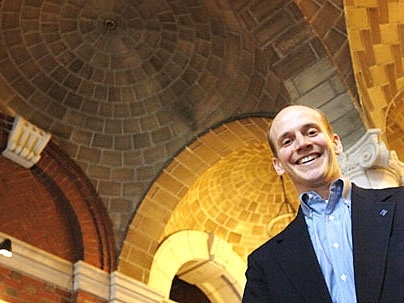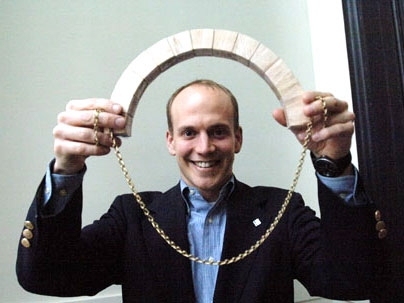Two MIT faculty members presented research and offered innovative perspectives on their fields at the annual meeting of the American Association for the Advancement of Science (AAAS) held February 16-20 in St. Louis.
John Ochsendorf, assistant professor in the Building Technology Program, and Henry Jenkins, director of the Comparative Media Studies Program, presented papers at the AAAS meeting, which was attended by more than 6,000 people, including 900 scholars and scientists. The meeting's overall title was "Grand Challenges, Great Opportunities."
Ochsendorf provided a press briefing in a symposium, "Arches: Gateways from Science to Culture," which was part of a daylong series called "Beyond Pi: Grand Challenges in the Mathematical Sciences."
Optimizing architectural forms
A structural engineer specializing in architectural and construction history, Ochsendorf presented a virtual design method that has been extended in novel ways by a team of architects, computer scientists and engineers at MIT.
The method, known as particle-spring systems, is a three-dimensional design tool that was originally developed by computer scientists for creating graphics such as character animation and cloth simulation. For example, particle-spring systems produced the clothes "worn" by virtual characters such as Yoda in "Star Wars Episode III: Revenge of the Sith."
The interdisciplinary MIT team proposes to employ particle-spring systems dynamically: They are using the software, which models the gravitational load on a given shape's exterior, to find a structure's most efficient form and to allow the architect or engineer to interact with the form-finding program while it is still running.
When it is running, the team's software program displays arching lines that look like white daddy-long-legs spiders, delicately dancing on a black field as they seek efficient forms. The program can also be used for modeling structural elements, such as trusses, slabs and beams.
Historically, finding and creating new structural forms was accomplished by painstaking physical means. Antoni Gaudi, Spanish architect and designer of the chapel of Barcelona's Colonia Guell, devoted 10 years to a "hanging chain" model made of weights on strings that would serve as an upside down version of the efficient arched forms he sought.
MIT's virtual method, Ochsendorf said, is as straightforward as Gaudi's physical method for exploring and testing new forms, but it uses time, materials and money more efficiently.
"Using the particle-spring approach, a three-dimensional structure such as a cathedral can be created in only a few minutes. Most importantly, the user can change form and forces in real time while the solution is still emerging," Ochsendorf and Axel Kilian (Ph.D. 2006) wrote in a recent paper, "Particle-Spring Systems for Structural Form-Finding."
Ochsendorf also envisioned MIT's particle-spring systems method being used to analyze and illuminate historic masonry methods (these secrets were closely guarded by guilds) and to support sustainable modern building practices by discovering more efficient -- and less-resource-consuming -- structures.
Studying kids online
Jenkins spoke at a symposium titled "It's 10 p.m.: Do You Know Where Your Children Are ��� Online" in the AAAS series, "Kids Online - A New Community."
Jenkins, the principal investigator for the New Media Literacies project in the Comparative Media Studies Program, presented some of the project's early research findings.
He focused on 21st-century literacy, which is based on the ability to read and write and includes the digital skills to participate socially and collaboratively in the new media environment.
Jenkins proposed that there is a high 21st-century literacy rate among teens -- measured by their skillful use of all things digital, including instant messaging, Myspace, sampling, zines, mashups, Wikipedia, gaming and spoiling - that has far more meaning than "screen time" implies.
"Social connectivity, creativity and learning take place through these various media-related experiences," said Jenkins, long a proponent of open-mindedness towards new media and of respect for its political and creative potential.
He tirelessly contrasts passive media consumption -- the slug on the couch -- with the activities of digital culture. The latter is essentially participatory, meaning it has "relatively low barriers to artistic expression and civic engagement, strong support for creating and sharing what you create, and members feel their contributions matter," he noted.
Adults should encourage young people to participate fully in digital culture; this, in turn, will help them develop the "skills, knowledge, ethical frameworks and self-confidence needed to be full participants in the world around them," he said.
Rather than focus on the negative effects of media consumption -- the dreaded "screen time" -- parents and teachers should seek to eliminate the "participation gap" between affluent students' digital resources at home and those available to less affluent students at school.
"This may be what is most radical about the new literacies -- that they enable collaboration and knowledge-sharing with large-scale communities. Right now, our schools are still training autonomous problem-solvers. But as students enter the workplace, they are increasingly being asked to work in teams, drawing on different sets of expertise and collaborating to solve problems," he said.
Jenkins' new book, "Convergence Culture: Where Old and New Media Collide," will be published this summer by New York University Press.







